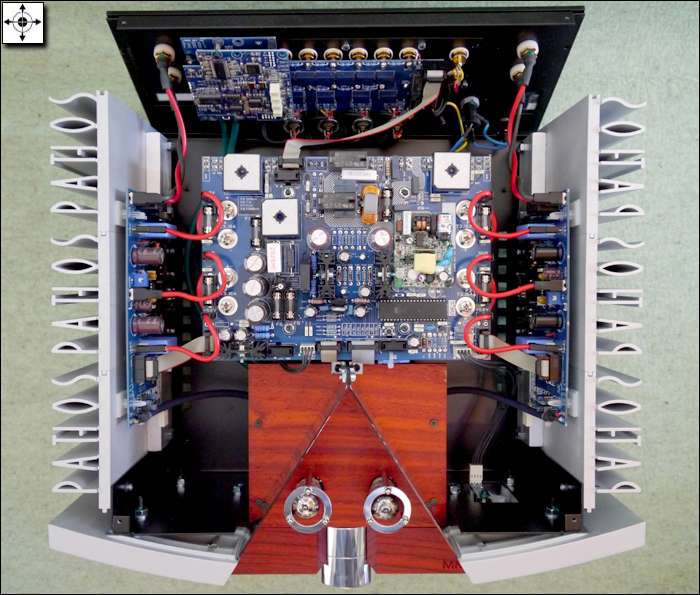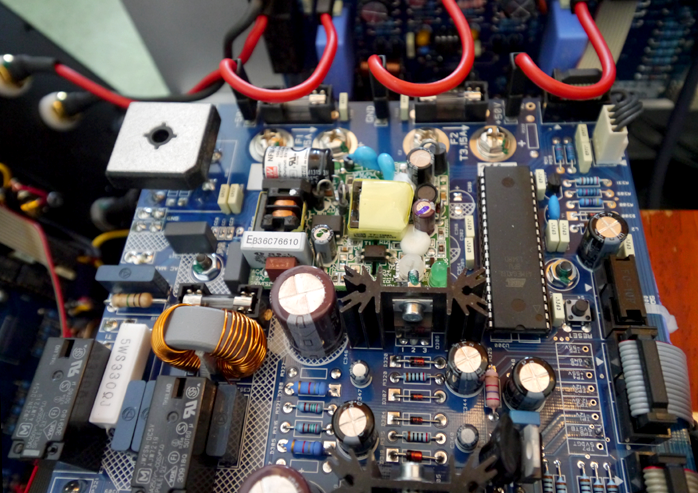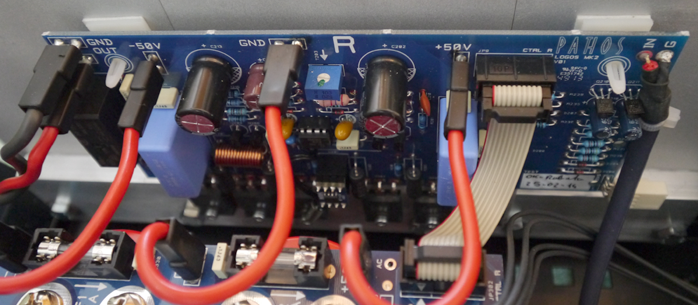Pathos Acoustics Logos MkII 6moons.com Review

Reviewer: Srajan Ebaen
Financial Interests: click here
Source: 2TB iMac 27″ quad-core with 16GB of RAM (AIFF) running OSX 10.8.2 and PureMusic 1.94g in hybrid memory play with pre-allocated RAM, Audirvana 1.5.10 in direct/integer mode 1, Metrum Hex, SOtM dX-USB HD with Super-clock upgrade & mBPS-d2s, AURALiC Vega, Apple iPod Classic 160 AIFF-loaded, Cambridge Audio iD100, Pure i20, Pro-Ject Dock Box S Digital, RWA-modifed Astell&Kern AK100
Preamplifier: Nagra Jazz, Bent, Audio Tap-X, Esoteric C-03Power & integrated amplifiers: FirstWatt S1 monos, SIT2; Crayon Audio CFA-02, Bakoon AMP-12R, Goldmund/Job 225, Gato DIA-250, Clones 25i [on loan], Aura Note Premier
Loudspeakers: soundkaos Wave 40, Boenicke Audio W5 & B10, German Physiks HRS-120, AudioSolutions Rhapsody 200, Zu Audio Submission, Eist Audio Dubh [on review]
Cables: Complete Zu Event loom; KingRex uArt, Zu Event and Light Harmonic LightSpeed split USB cables; Tombo Trøn S/PDIF; Van den Hul AES/EBU; AudioQuest Diamond glass-fiber Toslink
Powerline conditioning: GigaWatt PF-2 + Vibex Two 1R on amps, Vibex Three 11R on front-end components
Equipment rack: Artesania Exoteryc double-wide three tier with optional glass shelf, Rajasthani hardwood rack for amps
Sundry accessories: Extensive use of Acoustic System Resonators, noise filters and phase inverters
Desktop system: iPod/AK100 digital transports, Wyred4Sound minT, Gato Audio DIA-250, Gallo Strada II + TR-3D
Room size: Irregularly shaped 9.5 x 9.5m open floor plan combines the living/listening room, kitchen and office. Added to this space the speakers see the air volume of the entry hall and a long corridor plus the 2nd-storey 6 x 9.5m loft. Wood-panel ceiling slopes up to the loft. Parquet flooring. Lots of non-parallel surfaces (‘vertical gable’ windows, twin-angle ceiling, spiral staircase enclosure, fireplace enclosure). For a pictorial tour, see here.
Review component retail: €4.300 for base version, €700 for optional digital module

I’d worked with Enrico Fiore when he handled S&M—sales and marketing—for Sonus faber. Now he was at Italian hifi firm Pathos to tell me about their Logos integrated optionally available with DAC module. This beefy hybrid combined a 2 x ECC88/6922 class A fully balanced preamp stage with a 110/220wpc into 8/4Ω class AB Mosfet output stage sans feedback for a 5Hz-140kHz response at ±0.5dB. That’s admirably wide bandwidth. For precise remote-controlled volume there’s a BB PGA2310 digitally actuated analog resistor-array chip to replace a conventional pot. There are 2:5 XLR:RCA inputs and one each variable and fixed output. The digital board adds 2 x S/PDIF coax and 1 x USB type ‘B’ class 2.0 for 24bit/192kHz compatibility. Though the preamp stage is valved, the transistor outputs are non-inverting. Input impedance is 32KΩ/20KΩ on RCA/XLR. Dimensions are 42 x 42 x 17cm DxWxH. Weight is a confident 28kg

Before you protesteth too much—that this is a very old hat, 10 years so in fact—the updated MkII version under review is brand new. This includes higher anode voltages for the valves to operate at higher linearity. A newly stabilized power supply for these bottles and superior electrolytic caps are said to create “quicker on-demand energy” for “better dynamics, detail and timing”.

The II is also modernized on features. Levels can be stored for each input as well as gain assigned and display brightness adjusted. Standby is remote actuated to appease latest EU energy consumption commands. Hall effect sensors protect against short circuits and overload.

Better sound, higher safety, greater feature smarts. That’s the promise.

Just as you’d expect, coming from Vicenza the Logos MkII on style is pure italiano. The wood-ensconced chrome-rimmed display doubles as volume knob. The heat sinks spell out the company name in elongated letters.

The balance between flash and understatement is most keenly observed.

The front baffle curves, the Padauk wood trim veers backward into a triangle rimmed by mirrors to reflect the small-signal bottles.
The top cover sports seven micro-perf circular cooling vents in a classy two-tone scheme. Where lesser stylists would shun asymmetry to pursue some idealized but static notion, Pathos adds two small chromed push buttons to the right of the wooden center detail but none to its left. Bravo! It’s such assuredness of industrial design that can make the decisive difference between smart but trite and truly interesting. This is pure class if more opulent than stark.

Lest your knees jerk, about hybrid tech, real-world power and Milanese style threatening an extended beans’n’rice diet to finance… the Logos MkII wants €5’000 fully loaded. Already dac’d out? Subtract €700. That’s no chicken feed but surely no audiophile trophy pricing either. By now you’ll have figured out why I accepted Enrico’s solicitation. This was a 10-year proven circuit refined for the 21st century. It combined vacuum and solid state. It looked swell. It had bandwidth. It had low-impedance power. It was priced fairly particularly for EU manufacture. How would it impress in the sweet spot?
The lay of hybrid land. With pure valve machines a full half of their catalogue, Pathos’ Italian colleagues at Unison Research offer similar hybrids in their Unico range. Meanwhile George Kaye’s Moscode hybrid is an American sample of the breed. When Dan Wright of ModWright bowed his first integrated, many expected it to be another. Instead it went all transistor. Enter a former Sonic Frontiers designer now working in Serbia under the cunning Beyond Frontiers Audio banner. Their very big Tulip A hybrid sports a novel wrinkle. Its tube linestage is DC coupled to avoid all capacitors and interstage transformers. That’s a breakthrough if you believe transformers to limit bandwidth and introduce phase shift; and signal-path caps to be plain bad for sound.
* The Tulip and their monos of course do get huge 4 x 47000µF Mundorf electrolytics in their power supplies.

Conventional hybrids must use electrolytics in their valve power supplies and better types (or transformers) for their interstage coupling. BK Butler’s Tube Driver Blue circuit combines small-signal triodes and bipolar Sanken transistors with output-load mirroring circuitry whilst his Monad version loads 300B power triodes with transistor followers and backs it with a 2’000’000µF power supply. Frank Blöhbaum’s breakout Thorens amp combines balanced tube drivers with ultra-power single output transistors per Circlotronic phase. Alex Peychev combines a DHT input stage—45, 2A3, 300B or other—with monaural transistor current buffers in his new APL Hifi Reference HA-Master. Burson Audio had a transistor amp whose voltage-gain stage could be bypassed to strap to a traditional low-power transformer-coupled valve amp as a pure current buffer.
Nelson Pass’ FirstWatt F4 with negative voltage gain could be exploited in the same way. And there are even ‘inverted’ hybrids from KR Audio which perform the voltage gain with solid-state whilst the final speaker-drive stage runs on power triodes. Inverting such inverted hybrids again finally gets us at Rogue Audio’s Hypex UcD amps which combine valved input stages with class D output stages; and similar efforts from Arion Audio.


Whether that way or in a single hybrid box, the basic concept is the same. Use tubes for voltage gain where their linearity excels; and transistors for current gain which nets higher direct-coupled power at far lower output impedance and noise to offer superior control over reactive loudspeakers. The purist advantage of the true hybrid rather than mix’n’match pre/power scheme is that it can avoid redundant gain and buffer stages. Ideally it’d be a simple two-stage affair. In the real world things simply get more complex again.


The 100-step Burr Brown volume control reflects in the two-digit alpha-numerical central display and can also be turned mechanically with the spring-loaded chrome cylinder surrounding the display. The input selector also triggers the display and “hi-tech miniaturized relays, originally developed for very high frequency telecom applications.”
In the company’s words, “after almost two years of design, prototypes, testing and listening, the new Logos integrated amplifier finally came as close as possible to the peerless quality of our proprietary INPOL technology [used in their TT, InPower and InControl top models and short for Inseguitore a Pompa Lineare or Linear Pump Tracker – Ed].”
For a quickie down memory lane, the company’s launch dates back to 1994 already. With Andrea Palladio’s famous architectural monuments in their home town of Vicenza which today is focused on metal production, jewelry and fashion, it’s no surprise that Pathos sees itself as making “hifi jewelry; small monuments”. Co-founder Gaetano Zanini operates a local high-end shop for plenty of benchmark testing. Paolo Andriolo is responsible for their industrial designs. Together the team calls theirs “the unorthodox approach”. All their products are handcrafted on site which in 10 years changed location twice to scale up with internal growth. A subsequent relocation increased the previous space by five times again.

Arrival. One difference between newbs and veterans in this sector is packaging. The former skimp to ‘save’ money which bites you and them on the arse when product shows up damaged; or the packaging can’t ever be reused. Veterans accept that proper packaging will cost more than a pair of tweeters in a speaker or perhaps all your luxo socketry combined if you’re an amp maker. The Logos MkII didn’t skimp. It arrived triple-boxed and then some. It was properly battle-hardened to take on Oops, FedUp and the usual suspects.

Response to the la bella vida cosmetics could be divided. Ivette found them vulgar in the extreme. The fact that the heat sinks spell out the company name three times over per side became yet further vanity indictment. There’s no question. The looks are opulent and highly stylized. Hence reactions won’t be lukewarm. I bet that those who are bored to tears with our usual folded sheet-metal boxes will adore the Logos MkII and give it extra marks for its haute couture threads. Part and parcel of the stylized approach is total lack of indicators on the remote’s six silvery buttons. You want chic, you can’t have pedestrian markers. Better learn your magic wand spells to control volume and set mute, inputs, standby and display brightness.
Volume maxes out at 99, inputs display as A1-5 for analog, b1-2 for balanced and d1-3 for digital (if you’ve bought the binary module).

The volume barrel isn’t a continuously rotating affair but limits its mechanical range to precisely the width of its front baffle opening.

To increase the remote’s capture window, it relies on two IR emitters.

Popping the bonnet and flipping it upside down reveals how the Italians have fixed their metal-mesh cooling vents.

The business end sports, on RCA, a preout, tape-out and five line-level sources plus two coaxial digital inputs. Then there are two inputs on XLR, a 24/192 USB , a single pair of shrouded and slotted speaker terminals plus a toggle for the mains and the usual IEC power inlet with fuse holder above.
Getting more serious about the bonnet pop shows you this from the front…

… and this from behind if you’ve taken out the back panel’s three lower bolts to angle it back for a wee gander at the red soda-can caps living beneath the motherboard.

For the full-on geek routine in massive size, click on the ‘expand’ button to fill up your screen.

What follow are a few partial shots to complete out tour.

This clearly is a parts-dense circuit and not one of those mostly empty boxes which have you wonder where your money was spent.

The things hidden from view regardless are the actual output devices which are served by those snazzy heat sinks.

We finish off with an angle shot of the input relay and digital boards plus…

… a closer look at the upper digital board as well as that can be pulled off without having it lay out flat.
Greener pastures. With my Swiss soundkaos Wave 40 tone-wood speakers set up from the most recent outing, their sound-body action mimicking that of a violin or guitar by design, the Pathos MkII was far too portly and slow. On separation and articulation it was barely feathered or fanned out. In short order Jefferson Torno’s ‘ultra-linear’ Grand Cru Audio Horizon loaners took pride of place instead. With wide-bandwidth fast direct-coupled amplifiers à la Goldmund’s Job225 and Crayon Audio’s CFA-1.2 for stark contrast, a few things became crystal clear out of the gate. Even on the very accurate French d’Appolito towers with ribbon tweeters, the Italian amp seriously downplayed timing and transient precision. Its reading of familiar tunes was far softer, thicker, fuzzier and frankly pudgy. It heavily prioritized weightiness, smoothness and general density. The price to pay was stark neglect of incision, energy transmission and quicksilvery reflexes. Everything sounded texturally bloated, blurry of focus and clumped together like a big mass of warm sound with very little articulation or distinctiveness.


Compared to the affordable Job225 whose snap and lucidity admittedly want superior transducers in no need of padding, the Pathos acted sleepy, groggy, indecisive and sonically far more primitive. Lower playback levels were painfully boring and uninvolving. The many virtues of the Horizon speakers were cloaked in a veil. They sounded like a bad version of a vintage Sonus faber instead of like themselves.
Swapping in my highest-resolution speaker on hand which was still in from its review, in the off chance that it’d tip the balance, accomplished nothing substantial. This EnigmAcoustics Mythology M1 paled by comparison to what the Crayon Audio CFA-1.2, FirstWatt SIT1 and Job225 get from it. There was no doubt in my mind. I’d given the Italian my most copasetic loads. Moving in my Boenicke Audio B10 or German Physiks HRS-120 was for naught. What this amp really seemed to want to get anywhere near what I’d call on target was a Teutonically bright lean speaker; perhaps even some wiry very lit-up cables to match. That left me out and in the dark. With what I had on hand, the Logos MkII veered irreparably deep into plush coziness to quite miss the mark on anything I could get behind.

What faced me with was that unpleasant thing which challenges all reviewers doing it long enough. Whilst despising to go all dismissive like some self-righteous clown, we’re committed to calling things as we hear ’em rather than hide behind an easy policy of quietly sending back what passes us by. But make no mistake, hifi is just a hobby. It’s about preferences and personal hot buttons. Providers of hifi gear are in the business of offering us the most varied of such options. Simultaneously they mean to stay in business, keep their facilities open and their employees on the payroll. Irresponsible reportage mistakes failure to please one writer with universal defectiveness. That’s so wrong on so many levels. That stated, for an enthusiast writer to deliver more than just perfunctory reportage requires some wind in its sail to move forward and not in circles. No wind and the narrative inevitably stalls. That’s where I found myself. For another reality check after having played extensive musical chairs, I reverted again to the Mythology 1 driven by my Crayon. Instantly the sound as I knew it was back. Clearly the Logos MkII and I failed to see eye to eye and ear to ear.
| Having requested a fully broken-in unit and seeing no evidence of failure of any kind, the Pathos Acoustics Logos MkII and my resident hardware options simply didn’t get on. To not belabour this point with repetitive descriptions, I’ll excuse myself as the wrong person for this job. If my experience of it really coincided with what the MkII was meant to sound like, it’d take a writer of quite different ideas and priorities to do it proper justice. If as I suspect it was designed to sound quite different, I clearly lacked the proper hardware mates to see it so. In either case, I had to resign from the job. Out to pasture and all that. Some other reviewer is bound to find the same grass far greener… |
| |
| Postscript: In a subsequent email, Enrico Fiore of Pathos reminded me that this amplifier design has sold for about 14 years and enjoys thousands of very satisfied owners around the world. How could I possibly call it crap and all of those owners idiots by implication? Obviously I said no such thing. Yet people are bound to take this stuff very personal indeed, particularly so the actual maker and his agents. It thus seems opportune to reiterate that for a number of years now I’ve given valve amps a miss though I did own SETs and push/pull specimens of various power ratings for many more years. Since this shift in my listening preferences towards wide bandwidth ‘fast’ and very lucid transistor amps, my choices in speakers have changed as well. Perhaps I should have anticipated a mismatch with my boxes and listening bias? If so, I plainly failed. I would certainly encourage listeners fond of a more traditional valve sound who need power without reliability issues—the Logos MkII only uses small-signal tubes—to investigate this Italian integrated. After all, each and every review is always no more than just one man’s (or woman’s) experience and opinion. It couldn’t possibly invalidate the experiences and opinions of thousands of happy owners! https://6moons.com/audioreviews2/pathos/1.html |
0 Comments